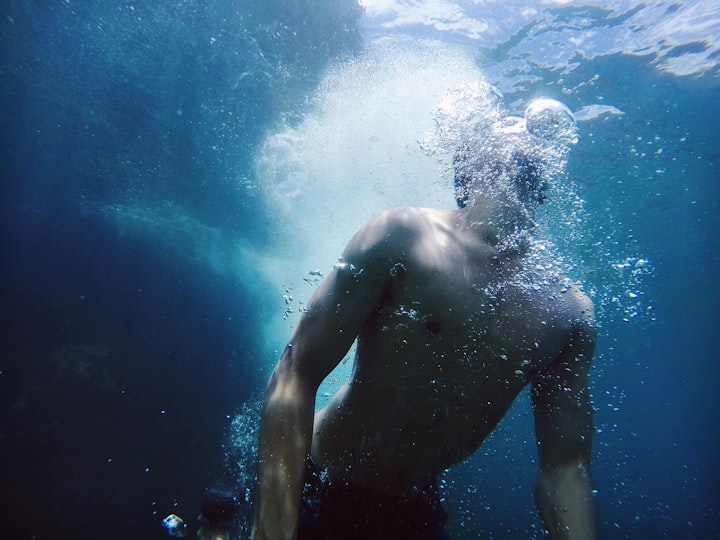
Water heals. This persisting belief was a gift from my young mind. Perhaps an innate understanding of a truth that many accepted as fact long before peer-reviewed articles declared the same. Water heals. I believed this as I swam the lengths of my hometown's iconic Z-shaped community pool. I believed because of the ineffable calm that overpowered my senses as I submerged my body. Faith in my restoration kept me afloat, not my particular matter and biology or the stringent lessons of my swim instructors. Even as I swam to the depths, I felt no panic as my body depleted itself of oxygen. The pressure felt like part of the healing process. I would push my lungs to the point of blackened vision until I reached some arbitrary milestone: a wall’s edge, a friend’s leg, or the bottom of the pool. The first gasp of air as you breach the water’s surface floods the system, and suddenly, you’re alive again.
I used to have a recurring dream that I was trapped underwater. Just as my mind would begin to waver and my body would sink deeper with defeat, I’d instinctually breathe in. Relief, not water, filled my body. I found the further I sank, the easier it became to breathe. Whatever body of water the dream took place in didn’t matter. It was different nearly every time. But, as long as I was near the bottom, I could survive. And heal. Some of the most vivid visions occurred beneath the Bathypelagic, where the night began and the earliest light formed; a place where my sight was limited to the needs of the creatures around me. The need to eat. The will of the hunt. I could stay there awhile, watching nature unfold. Silent and still, observing myself and the bioluminescence.
I worked at that community pool for six years and swam there religiously my entire childhood before employment. This passion for swimming, water, and the critters living in it, extended to every area of interest and focus in my youth. I tailored projects and class speeches to showcase my knowledge of the aquatic and educate my peers on preservation tactics. I knew I would grow to be an oceanographer or marine biologist specializing in shark biology. My dyscalculia changed my career plans around high school, but dysphoria had already been rotting the relationship between my body and water since middle school. The time of puberty, to be exact.
I began insisting that I wear swim trunks with my one-piece bathing suit. My boss and I exchanged words about that. Her insistence was that it slowed me down, and my insistence was that I was still faster than the men wearing trunks, too. And I often was. I wore them in protest once after our conversation, not thinking I had won but that I should have. My boss saw me swimming laps in my bright yellow swim shorts and blue bathing suit, hopped on the intercom, and berated me, “Take the shorts off immediately.” She announced to the entire establishment. I climbed out of the pool and began walking towards the locker rooms. At her behest, I stopped, stripped the shorts off onto the pool deck, and dove back into the water to continue my laps with minimal interruption. The entire exchange was on display for nearly 100 patrons. The intercom blared loud enough for even neighboring houses to hear. I was humiliated; whether people cared or paid attention didn’t matter.
I quit working at that pool a few years after that incident due to compiling microaggressions and other similar violences. I tried again at the first university I attended. Lifeguarding at a campus pool with fewer safety precautions and rules than I was accustomed to proved more challenging than I thought. I performed more “saves” during that month of employment than in my six years at the community pool. There is something to be said about that.
I swam a few more times after this. Typically, fully clothed, with swim trunks and a loose-fitting shirt of some sort. As I became more secure in my gender identity, I began experimenting with binders and chest tape. This experimentation alleviated dysphoria temporarily, but I still felt as though I needed to wear some sort of cover. I stopped swimming entirely. I began standing or sitting on the beach, deck, or lawn, clothes on, and watching my friends swim. My feet, ankles, and fingers were the only things to touch water outside my personal hygiene needs. Showers became my refuge, instead of the rivers, lakes, and lap lanes near me.
The submission to medical intervention for my gender dysphoria has proven to be the greatest release I’ve given myself yet. Particularly when discussing my ability to do the things I love most. Release, here, refers to the elusive phenomenon of freedom, one which necessitates permission. In this case, from myself. In another sense, it could be understood as surrender. The internalization of heteronormativity is a state of constant struggle. The structure of this particular brand of oppression is at odds with authentic expressions, identities, and kinship ties. Surrendering could mean letting this struggle go. For me, it meant honoring the image of my true self that I have held in my mind dearly since childhood, despite what others may think: a male appearance. A flat chest and beard, primarily. It meant unlearning and letting go of the harmful rhetoric I had been told to and ultimately decided to accept as fact.
I once believed that medically transitioning was wrong and (in my childish mind) gross. That softened as the awareness of my gender identity grew, and I realized I branched further from cis. I then would say that hormone replacement therapy was an acquiescence to pressure from social norms. I am an atheist, but my argument drifted frighteningly close to that of our bodies being our temple, a gift from God, meant to be preserved as “intended.” I thought, that if only media, advertising, and corporations didn’t lead us to believe our bodies were wrong, weak, fat, etc. then nobody would feel unhappy in theirs. Additionally, I felt gender norms created resentment across the spectrum of gendered experience and often led people to feel as though they didn’t strongly identify with the gender they were assigned at birth. I was convinced that it was entirely conditioning and stigma that influenced a person’s decision to seek HRT or surgical interventions. At the time, a desire to conform, fit, or pass seemed treasonous.
I don’t believe such insensitive, one-sided, and dangerous things anymore. I do still see dysphoria as a social problem, one created by the harmful default of heteronormativity, but no longer demonize those of us who choose gender-affirming medical treatment. My flat chest and beard don’t exist because of my desire to pass, but if they did, it would be entirely valid for the myriad reasons why it is valid for any of us. Hormones and top surgery have allowed me to more than crack a smile at the person I see in the mirror. My child self is ecstatic.
Honoring what I saw for myself before cultural norms and taboos influenced my decisions, is granting myself permission to be free.
Since queering my identity according to my self-determined values, my contentment and confidence have blossomed. So much so that I have felt the incredible urge to take to the water again. This time, as I’ve always wanted to, shirtless.
I imagine the feeling of seventy-eight-degree water surrounding my flesh. It soothes. My parasympathetic nervous system activates at the thought. Muscles relax, and the jaw unclenches. Healing in a body that is now mine by more than mere possession is a homecoming. I feel free.
About the Creator
kp
I am a non-binary, trans-masc writer. I work to dismantle internalized structures of oppression, such as the gender binary, class, and race. My writing is personal but anecdotally points to a larger political picture of systemic injustice.






Comments (1)
So this hit hard. And was really helpful. I am on the list for top surgery now, the waiting time is about six months and I have to make sure I can afford the recovery period. I appreciate this piece a lot.